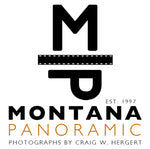ABOUT the Process
Over the years I’ve combined shooting film with digital capture that has blended into a perfect tool for capturing the massive landscapes of Montana. However, I now only use my large format panoramic film camera for specific outings and subjects only, as the costs of shooting has become a bit prohibitive. The price of large format film and processing for my view camera adds up to about $15.00 per click of the shutter….ouch. But the upside of this, is that in an age where memory cards are cheap and can hold hundreds and hundreds of images, the temptation to over shoot becomes much less of an issue. Planning, conceptualizing, and finding the perfect location, light, subject and composition become more of the focus, because when you only have 1 shot, you have to make it count.
In capturing the images, I use basically two simple tools, a large format 6x17 film camera with Fuji Velvia 50 slide film, and a few digital 35mm SLR's (Currently a Canon 5d Mark II, Mark III and 5dR) Shooting film is used for a variety of compositions when digital stitching will not yield the best result, such as when shooting moving objects and aerials. Film is a quite a bit more expensive to shoot today and I'm using it less and less. However, there is nothing quite like looking at a properly exposed giant 6x17 or large format color slide negative on a light box and seeing the amazing color and sharpness from the magic chemical process of film.

Film setup shot for "Summer in the Tom Miner Basin"
When film is not used, I use high resolution digital capture. All of the digital captured panoramic images are produced by shooting multiple 35mm photos in a row, or multiple rows shooting horizontal and/or vertical. Each photo is captured at the same time usually within 1 to 30 seconds depending on exposure needs. Using a level tripod and panoramic head with proper lens configurations is vital for an accurate stitch, especially in compositions with close up subject matter, or in low light situations. However, I find the tripod very constricting and heavy especially when hiking, and with much practice, have shot at least half of the images by rotating the camera by hand. After stitching the digital negatives together, the image is then cropped and adjusted to remove any dust or spots, and to fix any stitching anomalies that may have resulted during the overlapping process. With today's exact pixel matching stitching software, the resulting images are almost 100% accurate, although there may be the occasional overlap mistake. No digital changes to the photos are made except to patch very small areas of sky or other detail parts of the photo that may need repair after stitching, or as otherwise noted for illustration purposes.
To maximize proper exposures, I use a wide range of on-lens polarizing, neutral density, and gradient filters when shooting. In addition for both digital and film, I sometimes then utilize post production digital darkroom techniques such as graduated filters, dodge, burn and levels adjustments after color correcting in RAW format to produce the final digital negative used for printing. Once the final image is created, it is sized, saved and cataloged to the library, then backed up both on and off-site for safe keeping. Each image is then uploaded to the website for viewing, and offered as limited & open edition prints on a wide variety of the highest quality archival photo art papers.

Sample setup of filters for the "Impressions" series
I miss the old days of going into a darkroom, locking the door, turning on the red light then physically and mentally interacting with concept, technique, chemicals and paper. A science experiment, combined with a light capturing machine, artistic license, and a insatiable appetite to impart in the photographic process over and over again, creating something new, tangible and beautiful.
With the advent and progress of digital capture, it changed the way I saw the world by a removal of limitations. Starting with a slow Macintosh computer, a scanner and Adobe Photoshop 1.0 back in 1992, I was mesmerized by what I could do with digital. Then they released the new function of layers in 1994, and I was dumbfounded. Now I could do everything we were doing in the darkroom, but with much more precision, detail and control! The constraints of film were now all but gone, and the ideas and possibilities of digital were very, very exciting.

Underwater scuba setup for over/under shots - Ikelite housing
To me, shooting is only but one small part to the equation, as I love the whole photography process from start to finish. To go out and capture the light is one thing, but the magic of translating the minds eye to computer screen, to printer, to paper, frame then finally the wall, is as magical as the slow appearance of silver and gelatin in a chemical bath. Taking that image, finishing, framing and hanging the piece is as fulfilling as knowing that you’ve captured a moment in time that may never exist again. I pride myself on continuing to process, print and frame most all my own work these days, and even though it may be a slower time consuming process, I believe that anything worth while is worth working a little harder for.


 "Spring Evening Over Whitefish"
"Spring Evening Over Whitefish"